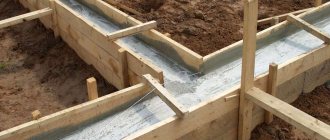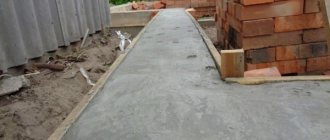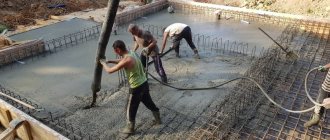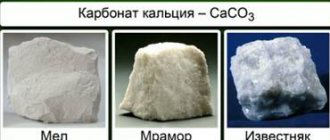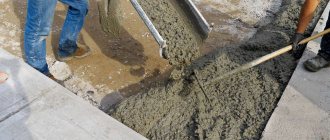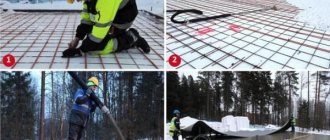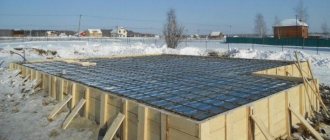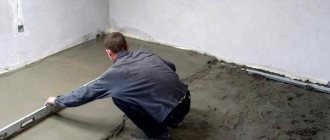Caring for the foundation after pouring is an important stage in the construction of a monolith. The quality of the structure depends on how the work is done correctly. The main task is to maintain the required humidity and temperature; for this you will need to organize watering and protect the monolith from wind and sun. How often, how much and why you need to water the foundation after pouring is a question that we will discuss below.
Proper aging allows you to extend the service life of the base
Why is watering necessary?
The active ingredients of a concrete mixture are liquid and cement mortar. They envelop the filler. Gradually, the water begins to evaporate and the binder begins to harden. During this process, the filler grains bind together and the liquid mixture becomes a monolith. If the top layer of the composition loses moisture faster than the middle, cracks may form. In addition, if the surface dries out, the product becomes less durable. Thus, the concrete product will not be able to meet the required grade.
How often should concrete be watered after pouring?
First of all, how long does it take to water concrete for the first time? To answer, you need to know when it will grab.
At +5℃ and below, watering the concrete with water is not required at all, it already hardens evenly. But even in this case, you still need to cover it with film so that it heats itself. However, at very low temperatures this may not be enough. Another problem arises - the water in the concrete solution freezes, and this affects the quality of the concrete. Antifreeze additives and electric heating systems are used.
Concrete watering frequency
Periodic moistening during the day and night allows you to maintain a sufficient level of moisture in the concrete.
The frequency of the procedure depends on weather conditions and the characteristics of the cement:
- When the air temperature exceeds +15°C, concrete is watered from the second day after pouring. You need to moisturize for 7-15 days.
- When the average temperature reaches +10°C, water for up to 1.5 weeks.
- In the first days, water 4-5 times a day, and after 5 days - several times, if it is not hot outside.
- In hot and windy weather, the intervals between watering should be at least 1.5-2 hours, and in cloudy periods - at intervals of 3 hours.
- Slag or pozzolanic Portland cement needs to be moistened 5-7 times a day for 2-3 weeks.
- Aluminous cement requires moisture for 7 days.
Less water evaporates from the concrete that is in the formwork. After its removal, the demoulded surface of the foundation also needs watering.
Preventing moisture evaporation from the surface of a concrete structure and from the concrete mixture
Why is there a need to protect freshly poured and compacted concrete mixtures from moisture evaporation not only from its surface, but also from the concrete mixture itself?
First, let's define what concrete is? The structural elements of the concrete mixture are: cement stone, coarse aggregate and sand.
After the concrete mixture has hardened, the structure of heavy concrete is a cement stone with aggregate grains embedded in it, which has many pores and voids of different sizes and origins.
To make cement stone, you need to mix cement with water. Moreover, there must be enough water for the cement to hydrate , and therefore for the concrete to gain strength.
Let's look at what cement hydration is and what role it plays in concrete production.
Cement hydration
Cement hydration is a chemical reaction of cement with water, during which liquid or plastic cement glue (cement + water) turns into cement stone. The first stage of this process is called thickening or setting, the second is called hardening or hardening.
The process of cement hydration is the most important and decisive in the entire production of a concrete structure. The change in any property of concrete is determined precisely by this process. The conditions under which the hydration process occurs determines the change in both the structure of concrete and its properties.
As the hydration process fades and ends, all changes in the properties of concrete fade and stabilize over time.
The cement paste itself, which turns into cement stone, is a hygroscopic substance (capable of absorbing water vapor from the air) since the cement particles are hydrophilic in nature (the ability to absorb water well), and the cement paste itself contains micropores.
During the process of cement hydration, large capillary pores appear in the cement stone, formed during the preparation of cement paste.
Why do pores appear in cement stone?
The fact is that for complete hydration of all cement minerals, that is, for cement to completely react with water, approximately 18% of the mass of cement is required (water-cement ratio W/C = 0.18). But in order to obtain a mobile, and therefore workable, mixture, much more water is added, and the value of the water-cement ratio in most cases varies from 0.4 to 1 (W/C = 0.4 ÷ 1). That is, 2 ÷ 4 times more water is added than is needed for normal mixing of cement.
What happens to the excess water that is not used to hydrate the cement? It evaporates, and in place of the evaporated water, capillary pores are formed, available for moisture migration. And the basic law of the strength of stone materials: the curve of the dependence of strength on porosity is hyperbolic in nature - the greater the porosity, the lower the strength.
In addition, during the process of hydration, a redistribution of water quality occurs: due to a decrease in the amount of free or capillary water, the amount of chemically and physico-chemically bound water increases. That is, in order for cement hydration to occur normally, a sufficient amount of free water is necessary.
GOST provides for determining the standard strength of concrete at the age of 28 days. In this case, it must harden at a normal temperature of 20 ± 2 ° C and a relative humidity of 90-100%.
The actual water content of cement stone depends on the ambient humidity. If the relative air humidity drops below 50%, the capillary pores quickly dry out, and the free water necessary for cement hydration evaporates.
In a dry, warm environment, some time after the free water has evaporated, the hardening of the concrete stops, which means the concrete stops gaining its design strength.
In addition, in fairly hot weather, and even with wind, rapid evaporation of water from the surface of concrete can lead to plastic shrinkage and the formation of shrinkage cracks in concrete. You can read more about this in the article “Shrinkage cracks in concrete.”
Thus, increased outside air temperature (more than 20°C) and low relative humidity (less than 50%) cause not only the rapid evaporation of water from the surface of the structure, but also the “pulling” of water from the concrete body through the pores, as well as its cracking. Therefore, in such conditions, either the structure should not be concreted at all, wait for more favorable conditions, or protective measures should be taken: it is necessary to retain moisture in the concrete in any way.
Protective measures to prevent water evaporation
To ensure the safety of water in the concrete mixture and in hardening concrete, it is necessary to cover the concreted structure with a waterproof or vapor barrier material. To prevent the formation of hairline cracks on the surface during drying, water loss should be prevented even before the concrete sets.
Since concrete is currently of low strength, it is necessary to cover its surface. This protection is only required in dry weather, but can also be used to protect the surface of fresh concrete from rain.
Currently, sealed films or waterproof paper are most often used for these purposes.
However, the film will effectively protect concrete from water evaporation, but will not allow water to penetrate to replenish the loss of the latter as a result of self-drying.
Therefore, when the concrete has set, especially when concreting in summer, in hot conditions, it is necessary to more intensively ensure the hydration of concrete in hardening structures. Wet curing is achieved by bringing the concrete into direct contact with water. This can be achieved by spraying or watering, or by covering the concrete with wet sand or soil, or wood chips or straw. You can use periodically moistened cotton mats or hemp and jute mats impregnated with a bituminous composition.
How to water concrete
- the first watering is done no later than 10-12 hours after pouring and compacting concrete in hot weather and no later than 24 hours in cool weather;
- The timing of humidification directly depends on the ambient temperature:
— at a temperature of +15 and above, watering the structure is continued for 10-15 days (until the structure reaches 70% strength);
— at a temperature of +10, watering is continued for 5-10 days.
- Until the sixth day of pouring, water the concrete surface at least 5 times a day. Next, watering the structure is reduced to 2-3 times a day, but only if it is not very hot outside.
Features of foundation care
The monolith is poured in the warm season, because at sub-zero temperatures the solidification process of the solution stops.
In summer, under the influence of weather conditions and internal processes, the temperature rises, so water quickly evaporates from the solution. The top layer of the monolith heats up more than the inner layer, causing it to harden faster.
As a result, gaps appear inside the foundation, which contributes to the formation of cracks. In winter, water gets into the cracks, freezes and breaks the monolith. To prevent this from happening, the base must be constantly wet.
Timely watering prevents the formation of expansion joints and tears
You need to carefully monitor the corners, since the sun's rays and wind hit them from both sides. The edges of the monolith dry quickly and then crumble, so they are watered and covered with film. To avoid causing mechanical damage to the corners, the formwork is dismantled a week after pouring. By this time, the concrete mixture will have gained sufficient strength.
It hardens best at temperatures from +18 to +22 °C and air humidity of 80%. If the temperature is above +25 °C, the monolith is covered with film or covered with sand. To prevent the film from being torn off by the wind, it is pressed down at the edges with a weight or stapled to the formwork. The film creates a greenhouse effect, does not allow moisture to quickly leave the solution, then the reaction continues and the concrete gains its design strength.
An example of covering a poured base with film
Typical mistakes when pouring and further caring for concrete
Let's talk about the most common mistakes that prevent the normal “aging” of the concrete mixture, can harm the future foundation, violate technical standards, or otherwise ruin all pouring work.
- Poor quality concrete mix. This can be expressed either in an incorrect ratio of the elements of the mixture, or, more often, in incorrect storage conditions. If the packaging was not sealed tightly, the roof of the barn was leaking, or the mixture was not stored at an insufficient height from the ground, water may have entered the cement, which could partially trigger the hydration reaction, so the material can no longer be used for pouring. Mixtures that have been stored for a long time and are sold at a very large discount should be treated with caution.
- Dilute the finished mixture with water before pouring it. If you have purchased a good mixture, its composition is determined in advance, production requires factory conditions and strict compliance with all standards. If the air humidity is high (100%), then there is no need to water the mixture even after pouring. If you break this rule, the strength of the material will be compromised, and it will be impossible to continue construction.
- Failure to use a vibration machine or bayonet to release air. If there is air in the mixture at the time of pouring, air bubbles will form in the concrete cavity, which will negatively affect its strength and subsequently lead to water getting inside and destruction of the material. At the same time, it is important not to overdo it, since excessively long vibration can lead to delamination of the material.
- Lack of regular flow. As mentioned earlier, if the air humidity is below 100 percent, periodic shedding must be performed.
- Lack of sufficient endurance. According to GOST, as stated, this period should be at least 28 days.
The article uses photographs from the site.
Maintenance of concrete structures
The main goals of surface care after pouring the foundation:
- reduction of plastic shrinkage;
- increase in strength;
- preventing drying out;
- neutralization of the influence of temperature changes;
- increase in service life;
- preventing the influence of chemical and mechanical forces.
To understand how much concrete needs to be watered, you need to know about the existing rules. Methods of care after pouring the foundation are influenced by:
- type of cement;
- type of construction;
- climatic conditions, etc.
The maintenance period is affected by the hardening speed of the cement in the mixture:
- structures made of cement, which hardens gradually, need to be wetted for 4 weeks;
- structures based on Portland cement - from 2 to 3 weeks;
- on quick-hardening cement - 8 days.
In hot and dry weather, longer maintenance is required. To slow the evaporation of moisture and to protect against overheating after pouring, it is recommended to cover the foundation with moistened sawdust, matting, and roofing felt.
In hot weather or strong winds, it is recommended to start irrigating the surface 2-3 hours after finishing work. Not everyone understands how to water correctly.
If you use a jet with strong pressure to moisturize, the plane that has not had time to harden may become deformed. It is recommended to use a sprayer to create an imitation of rain over the surface.
Watering should be carried out throughout the day so that the structure is constantly wet. You can understand how often you need to irrigate the surface by paying attention to the temperature and humidity of the air.
It matters how much time should pass between waterings. In extreme heat, breaks between moisturizing should not be more than 2 hours, in other cases - every 3 hours during the day, and up to 3 times at night. The appearance of hissing during irrigation indicates an insufficient amount of water.
Requirements for water for irrigation:
- must be clean flowing;
- it should not contain impurities that can have an aggressive effect on the surface;
- groundwater located close to the surface cannot be used;
- recommended pH level = 7 (permissible deviation - 1);
- must not contain pesticides or organic deposits;
- There should not be a large amount of calcium, magnesium, sodium.
On the foundation, which is in the formwork, moisture is retained longer, so irrigation is allowed less often. After removing the formwork, it is necessary to begin watering, paying more attention to the edges of the structure, since they are more susceptible to the influence of wind and temperature, so moisture loss occurs faster.
Sometimes, to preserve moisture, the surface is covered with a polyethylene film. During the evaporation process, water droplets end up on the inside of the film, and some of the moisture returns to the foundation. This technique allows you to reduce the number of waterings, but is not able to replace them completely.
What role does water play in the technical characteristics of concrete?
The main components of concrete are cement and water; they are the main materials before and after pouring the foundation. The solution gains its technical strength in direct proportion to the amount of evaporated moisture. Therefore, proper care after pouring is very important. It is necessary to water it with water, it provides:
- Minimum shrinkage of the poured mixture.
- Achieving high strength of the solution.
- Protects the poured mixture from premature drying.
- Provides a long foundation life.
Foundation spilled with water
Proper care of this building structure is quite important; the presence of water to solve this problem is necessary, since it:
- Takes part in all chemical and physical processes that occur in the poured mixture.
- On an open surface, moisture quickly evaporates, so the top layer of the mixture gains sufficient strength. But under it, in this case, there will be another layer in which moisture does not leave at the same speed as in the upper layer. The second layer will have less strength and will begin to collapse under load.
- As concrete hardens, it begins to lose its volumetric shape; water can compensate for this moment, but the amount of liquid for these purposes must be strictly regulated. If you go too far with the proportions, you can get a completely unstable structure, so you need to properly care for the solution after pouring.
- Climate plays an important role in the hardening of the solution. Maintenance of the foundation after it is poured should be carried out taking into account natural conditions. If there is wind, moisture will evaporate from the surface faster. Under such circumstances, cracks will form in the foundation very quickly, it will be loose and unstable to loads.
Possible consequences
In special frosty conditions, you must remember to follow all the rules for winter filling, otherwise irreversible consequences may occur, after which there can be no talk of any further operation of your facility. Therefore, you must strictly take into account all the standards and calculation data of this matter.
If you pour liquid into concrete during frost and do not do it correctly or with some, even minor, violations, then the thermal processes of hydration in the formwork, which proceed and are completed after about three to five days, may stop completely.
This leads to sad consequences; as a rule, the surface layer of your fill will be loose and crumbly. In this case, the work needs to be completely redone.
How many days to water concrete after pouring?
Experienced craftsmen can easily determine that the deep layers of the foundation have already hardened and know after what time they can stop watering. For others, the estimated time is two weeks, but it is worth considering:
- A type of cement used in concrete mortar. The instructions usually indicate how long it takes to harden. There is quick-hardening cement that only needs 8 days, while some types will take 4 weeks. Portland cement hardens completely in about 2-3 weeks.
- Season. In summer, the mixture heats up unevenly: the top layer hardens much faster.
- Exposure to sunlight. In the shade, concrete hardens more slowly.
You can estimate how long you need to water concrete based on the temperature:
- from 10 to 15℃ – 5-10 days;
- above 15℃ – 7-15 days.
Need for hydration
Often, those new to construction pour concrete into the foundation with their own hands and are sure that the work ends there. However, it takes time (up to 4 weeks) for concrete to gain the required strength.
Strength is influenced by ambient temperature and precipitation. Only after this period has expired is it possible to begin building walls (if we are talking about building a house).
If the ambient temperature is high and a strong wind is blowing, the process of evaporation of water from the outer layer will occur more intensely. And due to rapid drying, depending on its speed, precipitation will occur faster. This causes areas with numerous small cracks to appear on the surface of the structure.
When the hardening process is completed, under the influence of negative environmental conditions, cracks will contribute to the destruction of the concrete structure. In winter, water that gets into cracks freezes and can tear the structure apart.
When the foundation of a building is subjected to such destruction, cracks may appear on the facade, and their size will gradually increase. If the top layer is overdried, the process of cement hydration stops. Because of this, strength is gained slowly and is lower than the planned grade.
When the surface is wet during the hardening process, settlement occurs more slowly, the stress on the surface becomes weaker, and the risk of cracks will be minimal.
How many days should concrete be watered after pouring?
Many novice builders, after pouring concrete, naively believe that the work is finished and all that remains is to wait for the foundation to completely harden, but this is not so. Any experienced worker knows that concrete after pouring needs to be watered with water for greater strength. Moreover, the duration and frequency of watering depends on the ambient temperature.
Mixture composition
When we hear or say “concrete,” we rarely think about what this material is. And, of course, we don’t think at all about why all the instructions for caring for freshly poured concrete structures state that it is necessary to water the concrete. If we try to combine all the definitions found in the specialized literature into one, we will get a definition that explains that concrete is an artificial stone material that is formed by a rationally selected, thoroughly mixed and compacted, hardened mixture.
Concrete floor diagram.
Water and binder are the active components of the concrete mixture, which envelop the grains of the passive element of the concrete mixture - the aggregate - with a thin film. Over time, the water that softens the binder evaporates, the binder hardens and binds the enveloping aggregate grains, turning the mixture into a durable monolithic artificial stone - concrete.
How many days to water concrete after pouring?
Watering should be continued until the lower layers of the foundation are completely hardened.
Experienced builders do this intuitively, but novice craftsmen are better off sticking to certain parameters. The hardening time is most influenced by:
- Type of construction . The greater the percentage of the area exposed to direct sunlight, the faster hardening occurs throughout the entire volume.
- Type of cement . Different brands harden at different rates, so you need to carefully read the instructions for use.
- Climatic conditions . During the cold season, concrete hardens equally throughout its entire volume.
Pouring concrete in the fall: where to start?
When planning the construction of a concrete structure in the autumn, you should know what weather factors affect the quality of the final product or structure. There are several objective factors, and they are well known to construction specialists:
- Ambient temperature. The optimal temperature regime for setting and strengthening of concrete is a temperature “differential” from 16 to 25 degrees Celsius. As the temperature decreases, cement hydration slows down, which has a positive effect on strength gain. It is very important that the concrete does not freeze. If this happens, the frozen water will literally “tear” the flooded structure from the inside. This is the main danger that comes with pouring concrete in the fall;
- Increased environmental humidity. This is a positive factor that allows us to exclude constant wetting of the concrete surface from the technology;
- Rain and downpours erode concrete, wash cement out of the surface and reduce its strength. This is a negative factor;
- Groundwater. A negative factor that requires either carrying out measures to dry the site, or using special construction technology, or postponing construction to the summer.
Concrete grade
Concrete is a common building material, without which it is difficult to imagine any construction. It is used for the construction of monolithic buildings, various foundations, and reinforced concrete structures.
Conformity table of brands and classes
Depending on the task and location, the solution is mixed in different proportions, this determines the brand. It is divided according to three main characteristics:
- Grade is an indicator of the compressive strength of concrete, marked with the letter “M” and numbers. The number indicates what load the solution can withstand in kgf/cm2.
- It is also classified according to its water resistance. This indicator is marked with the letter “W”. The numbers show the pressure at which the solution does not allow water to pass through.
- It is also divided according to frost resistance. This indicator is designated by the letter “F”. The numbers show the number of freezing cycles after which the material does not lose quality.
Table for choosing the composition for frost resistance and water resistance
For each type of product, the appropriate brand is used. For example, high-rise buildings, bridges, strip foundations, roads - buildings with varying degrees of compressive and tensile load.
Why water concrete?
During the hardening process of concrete, special attention should be paid to moistening the composition. Why do you need to water concrete? There are a number of factors that prove this need
- Water is the main element of cement mortar. It participates in physical and chemical processes, as a result of which it is quickly neutralized. For optimal hardening of the concrete mixture, a certain amount of moisture is required, which must be compensated.
- The hardening of cement occurs heterogeneously. The upper layers are characterized by weak exchange processes and, as a result, the unstable hardened surface quickly deforms when the concrete layer inside is still liquid. In order for the structure to gain strength, it is necessary to ensure optimally identical conditions.
- During hardening, the base decreases in volume. You can make up for losses using a dosed amount of liquid.
- Climatic conditions are a factor that has a direct impact on the formation of a durable structure. Hot air promotes rapid evaporation of water, so the foundation needs constant watering. Windy weather leads to the removal of moisture particles from the cement, which provokes the appearance of numerous cracks in the surface.
Microcracks are one of the risks when forming a foundation. Through them, rainwater, dirt and dust enter the product. As a result, the surface remains intact, but the internal part of the structure is deformed. The formation of cracks and cracks in the foundation occurs in winter with strong temperature changes. When moisture gets inside, it turns into ice, which has the properties to expand and increase the size of the crack. Swelling of the base occurs, and after the foundation, destruction proceeds to the main structure. Water is involved in hydration processes. The optimal level of moisture contributes to the development of strength characteristics.
How to water concrete products
To moisten the structure it is recommended:
- use a hose with a sprayer;
- pay more attention to nodes and edges (in such places water evaporates faster, for this reason cracks or chips may occur);
- to prevent evaporation from the surface of a large area, cover it with film;
- distribute water evenly;
- Irrigate the base, in addition to the top layer.
In the first 2 weeks, the surface should be constantly wet; watering should be done regularly, not allowing the moisture to evaporate completely. If the surface is not moistened, premature dehydration occurs and the fragility of the material increases.
How to properly care for concrete structures
The foundation after pouring the concrete mixture. The rate of hardening of the solution. If it is made from Portland cement, then the hardening speed is up to a month, on concrete from alumina cement - up to a week. But here the climatic factor plays an important role, namely the temperature regime. The hotter the weather, the more evaporation occurs, and moisture deficiencies need to be replenished regularly.
Protecting the surface from evaporation. Alternatively, you can use burlap or film, creating a greenhouse or thermos effect. Here you can also use a pillow made of straw or hay, first filling it with plenty of water.
As a result, due to the exothermic reaction, the resulting heat will accumulate inside the closed space, moisture will condense on the inner surface of the film and return back to the solution. But the surface of the foundation must be constantly watered to compensate for losses in condensate.
Watering should be done only with a sprayer; pouring the foundation is strictly prohibited even in extreme heat. If water is supplied under pressure, it will destroy the outer layer of the foundation and penetrate inside, where it will not be used in the process of strengthening. Such foundations will not last even one winter period; within a year, wide cracks will appear along the walls.
Watering should be done regularly, making sure that the surface remains moist. Select the frequency depending on climatic conditions, ambient temperature and wind strength.
Concrete composition
Concrete is an artificial stone that is obtained after hardening. This happens when excess moisture comes out of the solution. This process is called maturation and lasts four weeks. During this time, stable connections between the components are formed.
Table of concrete proportions in kilograms per cubic meter
The mixture contains: cement, water, sand, gravel, and various additives. If necessary, they speed up or slow down the process of hydration - solidification. With the help of additives you can work in the cold season. Additives affect the elasticity of the solution and prevent shrinkage. But the main role is played by cement, sand, gravel, and water.
The condition of the concrete mixture depends on their quality.
Crushed stone
This is a natural material that is obtained by crushing rocks. Acts as a coarse filler.
Crushed gravel with fraction 5-20
It adds volume, prevents shrinkage, and creates the necessary strength. The strongest crushed stone is obtained from granite; cheap ones, made from slag, are also used. The amount of crushed stone in the concrete solution is at least 1/3 of the total volume. The crushed stone fraction comes in two types: 5–20 mm or 20–40 mm. The thicker the concrete slab, the larger the fraction needed.
Sand
Sand is a fine filler, the purpose of which is to add volume, ensure good cement adhesion, and, after drying, prevent it from cracking. The density of the material must be at least 1.5 kg/m3. fraction size 2–5 mm.
It is more expedient to sift this component from small impurities
River sand is used, which is well distributed in the solution due to its round shape. Sand is used clean, without clay and dust, the total amount of impurities should not exceed 5%.
Cement
Cement is a substance that binds components in concrete. Consists of clinker, gypsum additives, minerals. After cement gets into the water, solid formations are formed, with the help of which the sand and crushed stone are bonded. It is divided into several brands. The most used at home is the Portland cement brand.
Types of cement and their applications
You need to purchase finely ground cement, it dissolves quickly in water and sticks together better.
Water
It is better to use fresh water without harmful impurities. Sea and standing are not suitable for mixing mortar, as they contain a lot of salts and impurities that prevent the cement from hardening. For the hydration reaction to take place, 5% of the total mass is water. But they add more so that the mixture is fluid; it is convenient to fill the foundation with such a solution.
Table of the amount of water depending on the size of the crushed stone and the fluidity of the solution
Plasticizers and antifreeze additives
These are special mixtures that improve the properties of concrete. They allow you to work at sub-zero temperatures and can increase or decrease the rate of hardening. Modern additives affect not only the solution, but also the reinforcement used for the frame, making the mixture light, elastic or dense.
These additives allow you to fill the solution in the winter season
Plasticizers are used to accelerate strength gain. They reduce the amount of water in the mixture, which reduces cement consumption and makes it possible to obtain more durable concrete.
How long should you monitor the foundation?
This is where many builders make huge mistakes, which then cost them a lot of money. The surface must be constantly moistened, even if the structure has already achieved its original strength, but construction of the building has not yet begun. Also, the water must be purified and free of harmful impurities and easily soluble salts.
Criteria for choosing water for moistening foundations:
- Clean running water without harmful impurities;
- This should not be groundwater from high horizons;
- pH should be 7.0 within a deviation of up to 1.0;
- Water should not contain pesticides, organic deposits and large amounts of calcium, magnesium, and sodium compounds.
As a rule, moistening is carried out until the structure reaches the calculated 70% strength. The period is approximately 2-3 weeks, less often a month. Then moisturizing is no longer practiced. Also, it does not need to be done when the ambient temperature is below 5 degrees Celsius. In such climatic conditions, excess moisture will only do harm.
How often should concrete be watered after pouring?
As a last resort, the procedure is performed 10 hours after the end of concreting, but only if the weather permits. In very hot or windy weather, the first watering should be done after 2-3 hours. You need to water the foundation day and night, constantly keeping the top layer moist. If the weather is very hot or windy, watering should be done every 1.5-2 hours, increasing the interval in the morning, evening and night. The weather can be considered hot when the temperature in the sun is more than 15 degrees. At an air temperature of 15 degrees, you need to water every 3-4 hours during the day and 1-2 times at night. If the weather is 5 degrees or less, then there is no need to water the concrete.
In theory, you can make a schedule from these 3 points and water according to it, but it is much more reliable to touch the concrete to understand whether it is wet enough or not. If it is not possible to water frequently on a schedule, then you can apply a layer of wet sawdust, roofing felt to the surface, or shade the area. Also, the concrete should be covered with plastic film so as not to increase the interval between waterings, and this will also have a positive effect on the result.
Winter care
All construction and repair work that involves the use of concrete mixture is not recommended to be carried out in cold weather, i.e. in winter. Construction in the cold season will require additional financial costs.
If the air temperature drops below 0°C for a short period of time and then rises above +5°C, frost is not critical. In order for the structure to harden properly, special anti-frost modifiers are added to the solution. They prevent the mixture from freezing. If they are not used, it is recommended to heat the solution before pouring and wrap it.
At large construction sites, special heaters can be used in winter. At home, their use will be expensive. Caring for concrete in winter means keeping it warm. Heating is necessary in order to retain the thermal energy of hydration in the solution.
How long does it take for the foundation to dry?
It takes an average of one and a half to two months to dry. Block foundation
, which is one of the most difficult to install, also dries completely in about one month.
A pile-screw foundation
does not require any waiting at all: the walls are erected immediately after the piles are twisted.
Interesting materials:
Which microphone is better for gaming? What kind of frost can yucca withstand? How powerful should a car vacuum cleaner be? How powerful should the spray gun be? How powerful should a fabric steamer be? What power should a gas gun be for installing suspended ceilings? What kind of juniper for bonsai? Which juniper is best for bonsai? Which juniper causes rust? What's the best multitool?
Advantages and disadvantages
Winter construction has its pros and cons.
You should be very careful when buying concrete powder in winter, since during this period of the year the air humidity is quite high, the cement can get wet or become saturated with condensation - all this makes it unsuitable. Disadvantages include significantly reduced working hours due to shortened daylight hours.
The advantages include:
